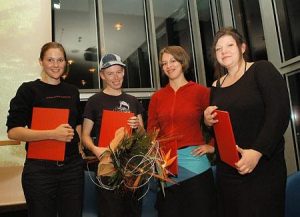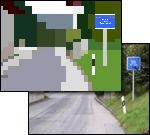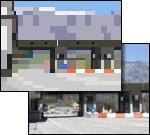2006 – Women Netart Award and Nomensland
Publication date: January 3, 2022
By CYM Simone van Groenestijn. A brief look back at what the internet once was like. A place of imagination, of really new ideas and of connecting.
It’s 2006

I am 32 years old and have been living in Austria for 7 years now. I am an active member of the Linux Netart Community in Graz and I do many art projects in Slovenia. I have been making “internet art” for over ten years. And since the late 1990s, I have been doing online collaborations with artists all over Europe, building virtual worlds online, and creating websites as art projects. All these years, the people around me don’t really understand what I actually do, but slowly there is more and more interest in the new medium “the internet”. By now everyone understands that they have to do “something” with it, but what exactly and in what way is still quite unclear to many.
It is the time when the boundaries between the former Eastern and Western Europe, in which I grew up, are increasingly blurred. In May 2004, Poland, Hungary, the Czech Republic, Slovakia and Slovenia will join the European Union. For decades there was a fence between Austria and the surrounding countries. Border controls between these countries are now slowly disappearing, only one border control is still necessary. The Austrian customs officers work together with their Czech, Slovak, Hungarian and Slovenian colleagues. If you want to cross the border, you only need to show your passport at one counter. Stickers will be placed on the border houses with the text “Drive on to the next house! Only there control!” In December 2007 the controls disappear completely and the border houses are demolished or turned into works of art by artists.
No Man’s Land or Nomens Land

During a photography workshop in 2004 in a village north of Vienna, we work with the theme “No Man’s Land”. For years, the borders around Austria were marked by the Iron Curtain, a wide strip of land with a fence that divided Europe into East and West. They are huge strips of land, from 200 meters to sometimes 300 meters wide, where it used to be dangerous to show yourself there. They are strips of land that are completely empty, where there was “nothing”, literally “nothing”. These are the strips of land you had to pass through when trying to flee from Czechoslovakia or Hungary to Austria. It was virtually impossible to get through without being shot.
The iron Curtain
After the disappearance of the Iron Curtain, there are suddenly zones of about 200 meters wide that are completely empty and that can be filled again. What do you do with all that space in an area where no one was allowed to come for years? A shopping center is being built on the border between Austria and the Czech Republic and a piece of the border area between Austria and Slovakia is being turned into a nature reserve where you can picnic and canoe. A crazy situation arises that you leave the country of Austria, but never enter the country of Slovakia or the Czech Republic. You stay in that huge strip of No Man’s Land where you can suddenly go out for a day.
From 2004 to 2006 I visit many of these places around Austria. I always look for the border between the countries. I build up a whole collection of photos, very ordinary photos, of a house, a road, a forest, a river, a front yard. What characterizes all these photos is that there are always two different countries to be seen in all these photos. Each photo shows a border area, two countries, two places, which for years were strictly separated from each other.
800×600
This collection of photos forms the basis for a website in which I convert the photos into HTML tables. I’m using a transparent gif to keep the tables sized. In the early days of the internet, it was very common to design your website as an HTML table. To make sure the distances in every row and column were always the same, you used transparent images, a “transparent gif”. There were no smartphones with which you could view websites. At that time, you could be reasonably sure that every visitor to your website could at least view a website in the 800×600 format. With an HTML table you could make your website fit perfectly.
“Nomensland”



All those photos and HTML tables together become an art project: “Nomensland”. (No Man’s Land with a typo in the name…) The HTML tables make up the work. If you want to see the original photo on which the work is based, click on “view source”. “View source” shows the code behind every page on the Internet. With this function, which is available in every browser, I learned to make websites in the 1990s. By looking at the codes for each website I found interesting and figuring out how the page was made, I discovered and learned the codes I needed to create my own websites.
The “Marianne.von.Willemer Frauen.Netzkunst.Preis.06”
In October 2006 I won a prize with this project, the “Marianne.von.Willemer Frauen.Netzkunst.Preis.06”. Marianne von Willemer was an actress and dancer known for her relationship with Goethe and the poems she wrote with him. She is a woman who has always been in the shadow of Goethe, as so many women are always somewhat in the shadows. The prize is an initiative of the city of Linz and is intended to support and give more visibility to female artists in Austria who are engaged in “net.art”. I see it as a great recognition that I can now receive this award.
The award ceremony will take place in a filled to the brim ARS Electronica Center in Linz. I have prepared a presentation for this evening in which I try to explain how my winning work is put together, how I made a joke in the project, because when you click on “view source”, instead of the HTML- code behind the page, see the original photo. I am trying to explain the relationship between the use of HTML tables and the borders in Europe.
It is not at all the intention that I give the people in the room a crash course in HTML. There is a jazz trio that plays music and there is a huge buffet, completely free for all visitors sitting in the ARS Electronica Center that evening. The evening is intended for the city of Linz to show a wider audience that they support women in the arts and technology. I secretly hope that I have made at least a few people in the room enthusiastic to get started with HTML themselves.
Also the year of…
In the same year, Facebook, Youtube, and Blogger made their appearance. It is the start of ocial media, of the Web 2.0. Anyone can now create a free Gmail account. Still “No Men’s Land” is one of the art projects I’m proud of. A project with a spelling mistake in the name, a project in which I could translate my love for HTML into my interest in Europe, a project in which I could connect real and virtual. A project that I still hope will one day end up in a museum.
It is now 15 years later. I still take a picture when I cross a border between two countries. And I still think it’s special when I can just drive on like this, when a border between two countries is no more than a sign along the road.
The original version of this blogpost was published in Dutch on 4 November 2021.


